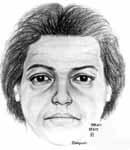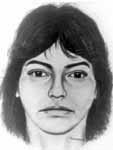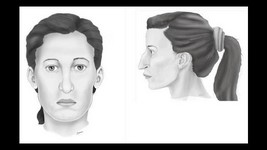http://www.officialcoldcaseinvestigations.com/showthread.php?14717-THE-TRUNK-LADY
The Frederick Post
Tuesday, July 5, 1983
Putting The Pieces Together
ANTHROPOLOGIST TRYING TO IDENTIFY TRUNK LADY
There's a woman Larry Angel wants to know more about. He has already learned much about the woman, probably enough to amaze her closest friends and relatives.
But he has too many open-ended observations without conclusions and gaping holes his nagging curiosity wants filled.
This isn't a love story, it's a story of an unidentified murder victim and the man who may help police find her killer.
The victim, known only as Jane Doe, was found last August on Frederick City's watershed. A Myersville couple were scouring the mountain for mushrooms when they stumbled across a brown and gold trunk.
With a rock, they broke open the lock and found the woman's putrid remains. How long she had been in the trunk is hard to say. Estimates have ranged from six weeks to six months.
Regardless, heat that built up inside the trunk had decomposed her body beyone recognition.
When city police could find no clues to her name of origin they sent the remains away for testing. Eventually the skeleton was sent to Dr. J. Lawrence Angel, an anthropologist with the Smithsonian Institution.
His laboratory is tucked away in the National Museum of Natural History. Even the most wayward museum visitors would find it difficult to reach the long, dark corridors leading to his lab.
Much of the floor has been set aside for storage of bones, skulls and complete skeletons from archeological digs.
Though cases holding the catalogued archeological finds clutter the halls, Dr. Angel's laboratory is quite spacious.
Sitting on one of his huge benches lies a wooden tray with Jane Doe's skeleton.
He pokes among the tray and reassembles the jaw to the skull. From it's shape alone, he states she was caucasian and "old American", that is, her family had been in this country for at least three generations.
"It doesn't mean she wasn't born abroad," he quickly adds.
From casual looks at other bones he says she stood about five-and-a-half feet tall. She was slender-limbed, broad hipped and probably in her 30s.
That's the cursory stuff, which may fit any number of missing women that police are searching for. A closer look provides revealing details about the woman's life.
"The broad skull base, and the full, round pelvis says she was probably well nourished. That would mean she came from a middle-class background or she might have been a farm girl", the 68 year old Angel says.
Then he holds up the bones of the spine, held together with a twine running up the whole where a spinal cord once fed information to the brain.
"The spine shows alot of stress, suggesting a lot of back-bending," he says, "My guess is she was a high school gymnast or a dancer. She might have worked in a factory where she was always lifting things."
"At any rate, she probably suffered back trouble," he continues. He goes on to other bones, saying she couldn't have been very muscular.
Then he points to one of the bones of the heels.
"The way these bones fit together, she probably wore high heels often," Dr. Angel observes. Then pointing to the bone leading to the small toe, he shows how it must have been injured, maybe fractured, at one time.
"She probably slipped on the ice, wearing high heels. It happened to my wife and my research assistant," he says.
Then Dr. Angel goes on to the woman's ribs. Using grey model clay he reconstructs how three ribs would have rested against eachother for some reason, each has a small ridge along the upper surface.
"I'd like to know what she did to have this," he says, "They don't belong there" his brow stitches, and he looks as frustrated as an expert crossword puzzle fan fumbling over what should be an easy clue.
The most remarkable feature of the "trunk lady", as Jane Doe has been dubbed in Dr. Ange;'s lab, is her dental work. Nearly all of her teeth show filling and two front teeth have been capped.
"Anyone with this much dental care should be easily identified," he says.
"But I don't understand this," he continues, pointing to the two skewed wisdom teeth in the palate.
"They must have caused her pain and I don't understand why anyone who has seen a dentist this often hasn't had these impacted wisdom teeth removed," he says.
The teeth may provide the best lead in identifying "the trunk lady," says Cpl. Robert Servacek, the acting chief of the Frederick City Police Criminal Investigation Division.
X-rays have been sent to dental schools in the area, on the hunch she was seen by student dentists, Servacek says. Police believe the work was done on Jane Doe indicated dental school type work.
Regrettable, he can find no definite cause of death.
"The styloid proceses (pointed extensions which hold the jaw in place below the skull) are broken. That suggested strangulation "but they could have broken post-mortem", he observes.
He paused to run his hand over the gray stubble on his balding head. Then he continues, "The thoracic vertebrae (the bones in the neck holding the head upright) is darker than the rest. That usually means it has been stained with blood. That could also mean strangulation, but then again, it also could have happened after she died."
To Dr. Angel, an enigma like the trunk lady is more than just helping solve a crime. Ever the scientist, he sees the work as helping himself as well. He has been able to apply the knowledge he gains from the remains of recent deaths to what he has unearthed in archeological digs in Greece and Troy.
The trunk lady hasn't been Dr. Angel's sole contact with Frederick County. He worked with historians exhuming the graves of the slaves who worked the Catoctin Furnace.
"It was quite an interesting find," he says, "Their bones showed they were certainly hard workers and they were well-nourished for slaves of the time," Skilled slaves, like the ones who worked iron and steel at the furnace, usually received better provisions than farm-working slaves, he adds.
His work on recent deaths, subsidiary work, he says, provides a sense of duty.He points to a poster resting beside more trays of bones. In Latin, penciled in gothic script, it says "This is the place where the dead teach the living," a saying Dr. Angel attributes to medieval medical schools.
"I give each sleleton the respect I would give a fine teacher," he says "There's much we can learn fromn them."
As he learns from Jane Doe's bones, he says he believes he must help in finding her murderer.
"That much we owe all cadavers," he says.

























